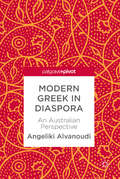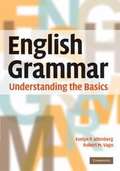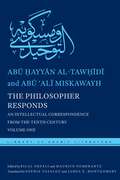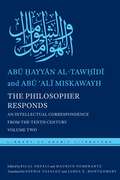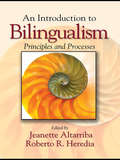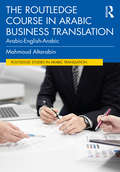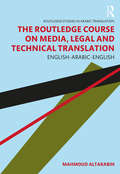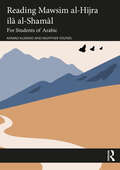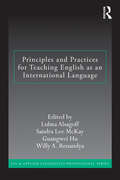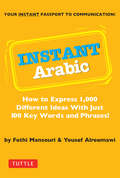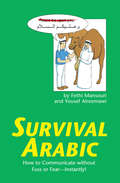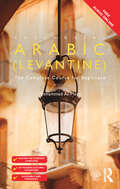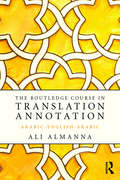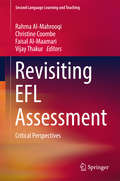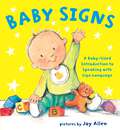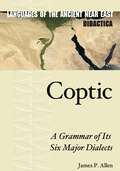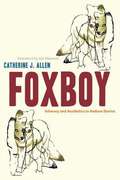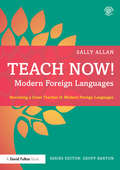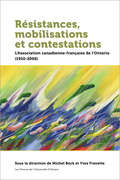- Table View
- List View
Modern Greek in Diaspora: An Australian Perspective
by Angeliki AlvanoudiThis book presents an in-depth fieldwork-based study of the Greek language spoken by immigrants in Cairns, Far North Queensland, Australia. The study analyzes language contact-induced changes and code switching patterns, by integrating perspectives from contact linguistics and interactional approaches to language use and code switching. Lexical and pragmatic borrowing, code mixing, discourse-related and participant-related code switching, and factors promoting language maintenance are among the topics covered in the book. The study brings to light original data from a speech community that has received no attention in the literature and sheds light on the variation of Greek spoken in diaspora. It will appeal across disciplines to scholars and students in linguistics, anthropology, sociology, and migration studies.
San Ferminetan, Lesakan
by John Andueza AltunaDonostiako Bilintx institutura itzuli da John Andueza Larunbatean Bukowskin nobela arrakastatsuaren ondoren; oraingoan, DBHko 4. mailako abenturak kontatzen dizkigu. Danel eta Ximon lagunak dira protagonistak, baita Ximonen andregaia Amaia, eta gelako tribu guztietako ikasleak ere: apatxeak, komantxeak, txerokiak, txeieneak, moikanoak eta baita payuk despistaturen bat ere. Ikasketa-amaierako bidaia egiteko asmoa dute, eta horretarako dirua lortzeko hainbat ekintza antolatuko dituzte. Baina ezusteko batek planak guztiz aldarazi beharko dizkiete.
English Grammar
by Evelyn P. Altenberg Robert M. VagoLooking for an easy-to-use guide to English grammar? This handy introduction covers all the basics of the subject, using a simple and straightforward style. Students will find the book's step-by-step approach easy to follow and be encouraged by its non-technical language. Requiring no prior knowledge of English grammar, the information is presented in small steps, with objective techniques to help readers apply new concepts. With clear explanations and well chosen examples, the book gives students the tools to understand the mysteries of English grammar as well as the perfect foundation from which to move on to more advanced topics.
The Philosopher Responds: An Intellectual Correspondence from the Tenth Century, Volume One (Library of Arabic Literature #19)
by Abu Al-Tawhidi Abu MiskawayhQuestions and answers from two great philosophersWhy is laughter contagious? Why do mountains exist? Why do we long for the past, even if it is scarred by suffering? Spanning a vast array of subjects that range from the philosophical to the theological, from the philological to the scientific, The Philosopher Responds is the record of a set of questions put by the litterateur Abu Hayyan al-Tawhidi to the philosopher and historian Abu 'Ali Miskawayh. Both figures were foremost contributors to the remarkable flowering of cultural and intellectual life that took place in the Islamic world during the reign of the Buyid dynasty in the fourth/tenth century. The correspondence between al-Tawhidi and Miskawayh holds a mirror to many of the debates and preoccupations of the time and reflects the spirit of rationalistic inquiry that animated their era. It also provides insight into the intellectual outlooks of two thinkers who were divided as much by their distinctive temperaments as by the very different trajectories of their professional careers. Alternately whimsical and tragic, wondering and brooding, trivial and profound, al-Tawhidi’s questions provoke an interaction as interesting in its spiritedness as in its content. This new edition of The Philosopher Responds is accompanied by the first full-length English translation of this important text, bringing this interaction to life for the English reader.
The Philosopher Responds: An Intellectual Correspondence from the Tenth Century, Volume Two (Library of Arabic Literature #24)
by Abu Al-Tawhidi Abu MiskawayhQuestions and answers from two great philosophersWhy is laughter contagious? Why do mountains exist? Why do we long for the past, even if it is scarred by suffering? Spanning a vast array of subjects that range from the philosophical to the theological, from the philological to the scientific, The Philosopher Responds is the record of a set of questions put by the litterateur Abu Hayyan al-Tawhidi to the philosopher and historian Abu 'Ali Miskawayh. Both figures were foremost contributors to the remarkable flowering of cultural and intellectual life that took place in the Islamic world during the reign of the Buyid dynasty in the fourth/tenth century. The correspondence between al-Tawhidi and Miskawayh holds a mirror to many of the debates and preoccupations of the time and reflects the spirit of rationalistic inquiry that animated their era. It also provides insight into the intellectual outlooks of two thinkers who were divided as much by their distinctive temperaments as by the very different trajectories of their professional careers. Alternately whimsical and tragic, wondering and brooding, trivial and profound, al-Tawhidi’s questions provoke an interaction as interesting in its spiritedness as in its content. This new edition of The Philosopher Responds is accompanied by the first full-length English translation of this important text, bringing this interaction to life for the English reader.
An Introduction to Bilingualism: Principles and Processes
by Jeanette Altarriba Roberto R. HerediaThis important text provides a general overview of the methods and theories used in the broad domain of bilingualism. The unique interdisciplinary approach, which is reflected in the various topics covered, gives students a global picture of the field. Topics range from early childhood intellectual development to educational and social-cognitive challenges to the maturing bilingual brain. Important developing areas such as cognitive aging, creativity, the social and cultural context perspective, communication disorders and sentence processing are also covered within the volume. This text is aimed towards undergraduate courses and graduate courses in psycholinguistics, especially those with an emphasis on bilingualism or second language learning.
The Routledge Course in Arabic Business Translation: Arabic-English-Arabic (Routledge Studies in Arabic Translation)
by Mahmoud AltarabinThe Routledge Course in Arabic Business Translation: Arabic-English-Arabic is an essential coursebook for university students wishing to develop their skills in translating different types of business texts between English and Arabic. Practical in its approach, the book introduces translation students to the concept of translation and equivalence in the context of business texts, business translators, and the linguistic and syntactic features of business texts. It also highlights translation tools and technology in addition to the translation strategies which can be adopted to render business texts between English and Arabic. Key features in the book include: • Six comprehensive chapters covering (after the Introduction) the areas of economics, management, production, finance, and marketing in the translation industry; • Detailed explanation of the lexical and syntactic features of business texts; • Practical English and Arabic business translation texts featuring a vast business vocabulary bank; • Authentic business texts extracted from English and Arabic books containing economic, management, production, finance, and marketing texts; • Great range of English and Arabic translation exercises to enable students to practice their familiarity with business vocabulary they learned throughout the book; and • Glossaries following all English and Arabic business texts containing the translation of main vocabulary items. The practicality of the approach adopted in this book makes it an essential business translation coursebook for translation students. In addition, the carefully designed content helps students to easily explore different types of business texts, familiarize themselves with main words, and do translation exercises. University instructors working on English and Arabic business translations will find this book highly useful.
The Routledge Course on Media, Legal and Technical Translation: English-Arabic-English (Routledge Studies in Arabic Translation)
by Mahmoud AltarabinThe Routledge Course on Media, Legal and Technical Translation: English-Arabic-English is an indispensable and engaging coursebook for university students wishing to develop their English-Arabic-English translation skills in these three text types. Taking a practical approach, the book introduces Arab translation students to common translation strategies in addition to the linguistic, syntactic, and stylistic features of media, legal, and technical texts. This book features texts carefully selected for their technical relevance. The key features include: • comprehensive four chapters covering media, legal, and technical texts, which are of immense importance to Arab translation students; • detailed and clear explanations of the lexical, syntactic, and stylistic features of English and Arabic media, legal, and technical texts; • up-to-date and practical translation examples in both directions offering students actual experiences of professional translators; • authentic texts extracted from various sources to promote students’ familiarity with language features and use; • extensive range of exercises following each section of the book to enable students to test and practice the knowledge and skills they developed from reading previous sections; • glossaries following most exercises containing the translation of difficult words; and • a list of recommended readings following each chapter. The easy, practical, and comprehensive approach adopted in the book makes it a must-have coursebook for intermediate and advanced students studying translation between English and Arabic. University instructors and professional translators working on translation between English and Arabic will find this book particularly useful.
Reading Mawsim al-Hijra ilā al-Shamāl: For Students of Arabic
by Ahmad Alswaid Munther YounesReading Mawsim al-Hijra ilā al-Shamāl: For Students of Arabic is intended for advanced students of Arabic who have studied the language for at least two years at college level or the equivalent. The book is based on Tayeb Salih’s novel Mawsim al-Hijra ilā al-Shamāl, a masterpiece in modern Arabic literature. This book is designed to accompany the novel, which the authors divided into 60 parts, each of which consists of 400–500 words of the original text. A lesson is built on each part and starts with a reference to the first and last sentences in it. This is followed by a list of new vocabulary and a variety of activities and exercises, some oral and some written, whose goal is to develop students’ listening, speaking, reading, and writing skills and knowledge of Arabic language, culture, and literature. The book ends with a glossary of literary terms. The book’s e-resources include a comprehensive glossary of words arranged by root, a glossary of expressions, and other resources. The book can be used as a main or a supplementary text in an Arabic language course or for independent study.
Principles and Practices for Teaching English as an International Language (ESL & Applied Linguistics Professional Series)
by Lubna Alsagoff Willy A. Renandya Guangwei Hu Sandra Lee McKayWhat general principles should inform a socioculturally sensitive pedagogy for teaching English as an International Language and what practices would be consistent with these principles? This text explores the pedagogical implications of the continuing spread of English and its role as an international language, highlighting the importance of socially sensitive pedagogy in contexts outside inner circle English-speaking countries. It provides comprehensive coverage of topics traditionally included in second language methodology courses (such as the teaching of oral skills and grammar), as well as newer fields (such as corpora in language teaching and multimodality); features balanced treatment of theory and practice; and encourages teachers to apply the pedagogical practices to their own classrooms and to reflect on the effects of such practices. Designed for pre-service and in-service teachers of English around the world, Principles and Practices for Teaching English as an International Language fills a critical need in the field.
Instant Arabic
by Yousef Alreemawi Fethi MansouriIt's amazing how 100 key words and phrases provide instant communication!Do you want to speak simple Vietnamese but are too busy to study it? Are you visiting the Arabic-speaking world for a short time and want an Arabic phrase book to help you communicate? If so, this is the book for you. It includes all the essential content necessary to speak basic Arabic.The idea of Instant Arabic is simple-learn 100 words and phrases and say 1,000 things. The trick is knowing which 100 words to learn, but author Fethi Mansouri has solved the problem, choosing only those words you'll hear again and again. Even with a vocabulary this small, you'll be surprised how quickly and fluently you too can communicate in Arabic. The pronunciation for each Arabic word in the book follows a precise and simple formula that will quickly become so familiar that conversing in Arabic phrases and sentences soon feels just as 'normal' as speaking English. Here's a sample of what you'll be able to do:Meet peopleGo shoppingAsk directionsRide the subwayOrder food and drinksAnd much more
Survival Arabic: How to Communicate without Fuss or Fear - Instantly!
by Yousef Alreemawi Fethi MansouriA handy Arabic phrasebook and guide to the Arabic language, Survival Arabic contains basic vocabulary necessary for getting around.This book contains all the necessary words and phrases for speaking Arabic in any kind of setting.<P><P> Perfect for students, tourists, or business people learning Arabic or travelling to the Arab world, it also contains a beginner guide to the Arabic language, allowing for a deeper understanding of Arabic than a typical Arabic phrasebook or Arabic dictionary. The book is organized by situations where one might need to speak Arabic such as: at the hotel, in a taxi, using numbers, etc. All Arabic words and phrases are written in Romanized form as well as Authentic Arabic script (Naskh) so that in the case of difficulties the book can be shown to the person the user is trying to communicate with.This phrasebook includes:Hundreds of useful Arabic words and expressionsRomanized forms, phonetic spellings, and Arabic script (Naskh) for all words and phrasesAn introduction to the Arabic AlphabetA pronunciation guide for Arabic letters and wordsA guide to Arabic grammarA section on specific titles and place names
Mi Mundo Estudios Sociales: La formación de nuestra nación
by Armando Cantú Alonzo Linda Bennett James B. KrachtNIMAC-sourced textbook
Colloquial Arabic: The Complete Course for Beginners (Colloquial Series)
by Mohammad Al-MasriColloquial Arabic (Levantine) provides a step-by-step course in Levantine Arabic as it is used today. Combining a user-friendly approach with a thorough treatment of the language, it equips learners with the essential skills needed to communicate confidently and effectively in Levantine Arabic in a broad range of situations. No prior knowledge of the language is required. Key features include: progressive coverage of speaking, listening, reading and writing skills structured, jargon-free explanations of grammar an extensive range of focused and stimulating exercises realistic and entertaining dialogues covering a broad variety of scenarios useful vocabulary lists throughout the text additional resources available at the back of the book, including a full answer key and bilingual glossaries. Balanced, comprehensive and rewarding, Colloquial Arabic (Levantine) is an indispensable resource both for independent learners and students taking courses in Levantine Arabic. Colloquials are now supported by FREE AUDIO available online. All audio tracks referenced within the text are free to stream or download from www.routledge.com/cw/colloquials. Recorded by native speakers, the audio complements the book and will help enhance learners’ listening and speaking skills. By the end of this course, you will be at Level B1 of the Common European Framework for Languages and at the Intermediate-Low on the ACTFL proficiency scales.
The Routledge Course in Translation Annotation: Arabic-English-Arabic
by Ali AlmannaThe Routledge Course in Translation Annotation: Arabic-English-Arabic is a key coursebook for students and practitioners of translation studies. Focusing on one of the most prominent developments in translation studies, annotation for translation purposes, it provides the reader with the theoretical framework for annotating their own, or commenting on others', translations. The book: presents a systematic and thorough explanation of translation strategies, supported throughout by bi-directional examples from and into English features authentic materials taken from a wide range of sources, including literary, journalistic, religious, legal, technical and commercial texts brings the theory and practice of translation annotation together in an informed and comprehensive way includes practical exercises at the end of each chapter to consolidate learning and allow the reader to put the theory into practice culminates with a long annotated literary text, allowing the reader to have a clear vision on how to apply the theoretical elements in a cohesive way The Routledge Course in Translation Annotation is an essential text for both undergraduate and postgraduate students of Arabic-English translation and of translation studies.
Revisiting EFL Assessment
by Rahma Al-Mahrooqi Christine Coombe Faisal Al-Maamari Vijay ThakurThis book examines acknowledged practices and demonstrates to teachers how to make the most out of their assessment practices. It also explores different assessment methods for skills such as reading, writing, listening and speaking. Forecasting the future of assessment and where concepts like alternative assessment and dynamic assessment are heading, it also shows how relatively new teaching methods such as communicative methodologies and problem-based learning are reflected in assessment. This book represents a forum where contributors have presented their research and innovative ideas and practices on the important topic of assessment and opened a fresh debate on it. It offers an excellent reference guide for EFL teachers, practitioners, researchers and testing and assessment specialists. Each chapter examines central issues inassessment and their connection with teaching and learning in EFL contexts.
Vox Latina
by W. Sidney AllenThis is a reissue in paperback of the second edition of Professor Allen's highly successful book on the pronunciation of Latin in Rome in the Golden Age. In the second edition the text of the first edition is reprinted virtually unchanged but is followed by a section of supplementary notes that deal with subsequent developments in the subject. The author also added an appendix on the names of the letters of the Latin alphabet and a select bibliography.
Baby Signs: A Baby-Sized Introduction to Speaking with Sign Language
by Joy AllenLong before they're able to talk, babies have a whole lot to say! Widen their world with this delightful modern classic—a must-have for growing families and a perfect baby shower or new-baby gift. With this adorable board book of essential signs, babies and toddlers can easily learn how to communicate their needs, wants, and feelings and even make basic observations with a simple gesture. Studies show that babies who use sign language feel less frustrated, throw fewer tantrums, and often learn to talk more easily. Just point to a sign in the book, say the word while making the sign, and the baby will soon be signing. Communicating a wet diaper or a hungry belly, asking for help or saying "all done" becomes as easy as waving hello or good-bye. And these are just a few of the thirteen signs inside this small and adorably illustrated board book, perfect for little hands and minds to grasp.
The Ancient Egyptian Language
by James P. AllenThis book, the first of its kind, examines how the phonology and grammar of the ancient Egyptian language changed over more than three thousand years of its history, from the first appearance of written documents, c. 3250 BC, to the Coptic dialects of the second century AD and later. Part One discusses phonology, working backward from the vowels and consonants of Coptic to those that can be deduced for earlier stages of the language. Part Two is devoted to grammar, including both basic components such as nouns and the complex history of the verbal system. The book thus provides both a synchronic description of the five major historical stages of ancient Egyptian and a diachronic analysis of their development and relationship.
Coptic: A Grammar of Its Six Major Dialects (Languages of the Ancient Near East Didactica #1)
by James P. AllenCoptic is the final stage of the ancient Egyptian language, written in an alphabet derived primarily from Greek instead of hieroglyphs. It borrows some vocabulary from ancient Greek, and it was used primarily for writing Christian scriptures and treatises. There is no uniform Coptic language, but rather six major dialects.Unlike previous grammars that focus on just two of the Coptic dialects, this volume, written by senior Egyptologist James P. Allen, describes the grammar of the language in each of the six major dialects. It also includes exercises with an answer key, a chrestomathy, and an accompanying dictionary, making it suitable for teaching or self-guided learning as well as general reference.
Coptic: A Grammar of Its Six Major Dialects (Languages of the Ancient Near East Didactica)
by James P. AllenCoptic is the final stage of the ancient Egyptian language, written in an alphabet derived primarily from Greek instead of hieroglyphs. It borrows some vocabulary from ancient Greek, and it was used primarily for writing Christian scriptures and treatises. There is no uniform Coptic language, but rather six major dialects.Unlike previous grammars that focus on just two of the Coptic dialects, this volume, written by senior Egyptologist James P. Allen, describes the grammar of the language in each of the six major dialects. It also includes exercises with an answer key, a chrestomathy, and an accompanying dictionary, making it suitable for teaching or self-guided learning as well as general reference.
Foxboy
by Catherine J. AllenOnce there was a Quechua folktale. It begins with a trickster fox’s penis with a will of its own and ends with a daughter returning to parents who cannot recognize her until she recounts the uncanny adventures that have befallen her since she ran away from home. Following the strange twists and turnings of this tale, Catherine J. Allen weaves a narrative of Quechua storytelling and story listening that links these arts to others—fabric weaving, in particular—and thereby illuminates enduring Andean strategies for communicating deeply felt cultural values. In this masterful work of literary nonfiction, Allen draws out the connections between two prominent markers of ethnic identity in Andean nations—indigenous language and woven cloth—and makes a convincing case that the connection between language and cloth affects virtually all aspects of expressive culture, including the performing arts. As she explores how a skilled storyteller interweaves traditional tales and stock characters into new stories, just as a skilled weaver combines traditional motifs and colors into new patterns, she demonstrates how Andean storytelling and weaving both embody the same kinds of relationships, the same ideas about how opposites should meet up with each other. By identifying these pervasive patterns, Allen opens up the Quechua cultural world that unites story tellers and listeners, as listeners hear echoes and traces of other stories, layering over each other in a kind of aural palimpsest.
Teach Now! Modern Foreign Languages: Becoming a Great Teacher of Modern Foreign Languages (Teach Now!)
by Sally AllanBeing taught by a great teacher is one of the great privileges of life. Teach Now! is an exciting new series that opens up the secrets of great teachers and, step-by-step, helps trainees to build the skills and confidence they need to become first-rate classroom practitioners. Written by a highly-skilled practitioner, this practical, classroom-focused guide contains all the support you need to become a great modern foreign languages teacher. Combining a grounded, modern rationale for learning and teaching with highly practical training approaches, the book guides you through all the different aspects of MFL teaching offering clear, straightforward advice on classroom practice, lesson planning and working in schools. Teaching and learning, planning, assessment and behaviour management are all covered in detail, with a host of carefully chosen examples used to demonstrate good practice. There are also chapters on the essentials of the MFL curriculum, pedagogical techniques, strategies to engage students in language learning, and how to succeed in observations and interviews. Throughout the book, there is a great selection of ready-to-use activities, approaches and techniques which will help put you on the fast track to success in the classroom. Covering everything you need to know, this book is your essential guide as you start your exciting and rewarding career as an outstanding MFL teacher.
Résistances, mobilisations et contestations: L’Association canadienne-française de l’Ontario (1910-2006) (Collection Amérique française)
by Gratien Allaire Serge Dupuis Mariève Forest Anne Gilbert Marcel MartelL’Association canadienne-française de l’Ontario (ACFO) a été le principal porte-parole politique de la collectivité franco-ontarienne au XXe siècle. Cette analyse historique en six chapitres chronologiques va de la fondation de l’Association canadienne-française d’éducation d’Ontario (ACFEO) en 1910 jusqu’à sa disparition et son absorption par l’Assemblée de la francophonie de l’Ontario en 2006. De 1910 à 1927, l’Association joue un rôle déterminant dans la crise du Règlement 17, qui interdit l’enseignement en français dans les écoles de la province. De 1927-1969, l’ACFEO contribue activement à l’avancement de la cause des écoles françaises (ou « bilingues ») de l’Ontario. Entre 1969 et 1982, l’Association, devenue l’« ACFO », travaille aux progrès institutionnels de la collectivité franco-ontarienne, tout en essuyant des critiques, voire des dénonciations formulées par plusieurs groupes de militants animés par les idéologies contre-culturelle et participative alors en vogue. Entre 1982 et 1992, l’ACFO se redéfinit pour s’adapter à la transformation de l’espace politique de l’Ontario français, ainsi qu’à la fragmentation de son champ idéologique sous l’impulsion de plus en plus irrépressible des régionalismes identitaires et de l’arrivée de groupes ethnoculturels issus de l’immigration francophone. Les années 1992-2006 sont les dernières de l’ACFO, qui ne peut se relever de la crise de légitimité qui la mine depuis la fin des années 1970. Une fenêtre privilégiée sur les efforts de construction identitaire et politique de la francophonie ontarienne au XXe siècle. Ce livre est publié en français. - The French-Canadian Association of Ontario (ACFO) has been the main political voice person for the Franco-Ontarian community in the 20th century. The first chapter (1910-1927) examines the first years of the Association and delves into the pivotal role it played during the debate surrounding Regulation 17, which was designed to prevent French-language schooling in the province. From 1927-1969, the ACFEO actively contributed to the advancement of French (or “bilingual”) schools in Ontario. From 1969-1982, the Association, now called ACFO, played a key role in the institutional progress of the Franco-Ontarian community, amidst much criticism and accusations made by militants inspired by the counter-culture and participative ideologies of the day. From 1982 to 1992, ACFO redefined itself in order to adapt to an evolving political situation in l’Ontario français, as well as to the fragmentation of its ideology as regional identities took shape to a new ethnocultural reality in the wake of francophone immigration. The years from 1992 to 2006 were the Association’s last, as it became unable to overcome a legitimacy crisis that had been undermining it since the end of the 1970s. A glimpse into the efforts that went into the identity and political construct of the Ontarian Francophonie throughout the 20th century. This book is published in French.
Romance Languages
by Ti Alkire Carol RosenTi Alkire and Carol Rosen trace the changes that led from colloquial Latin to five major Romance languages, those which ultimately became national or transnational languages: Spanish, French, Italian, Portuguese, and Romanian. Trends in spoken Latin altered or dismantled older categories in phonology and morphology, while the regional varieties of speech, evolving under diverse influences, formed new grammatical patterns, each creating its own internal regularities. Documentary sources for spoken Latin show the beginnings of this process, which comes to full fruition in the medieval emergence of written Romance languages. This book newly distills the facts into an appealing program of study, including exercises, and makes the difficult issues clear, taking well motivated and sometimes innovative stands. It provides not only an essential guide for those new to the topic, but also a reliable compendium for the specialist.
